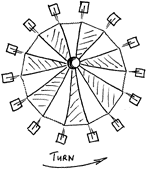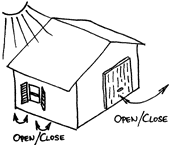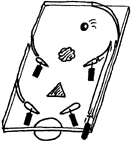![[Jump to Cover]](cover.gif) |
![[Jump to Contents]](contents.gif) |
![[Jump to Introduction]](introduc.gif) |
![[Jump to Concepts]](concepts.gif) |
 |
![[Jump to Conclusion]](conclusi.gif) |
![[Jump to Appendix]](appendix.gif) |
3 Realization
3.1 Suggestions and Wishes
In order to get in touch with the kids and mentors at the CCE, participation in the daily life at the Clubhouse has been an essential aspect of the project from the very beginning. According to their curriculum at school and other activities, most kids come to the CCE on certain days of the week. In addition to these regular visitors, there is also a significant number of kids who come on a rather irregular basis, e.g. once in a month.As the CCE offers a great variety of activities, the kids’ foremost reasons to come to the Clubhouse are very different, as well.
Browsing the Internet and chatting is what most of the kids tell spontaneously when asked about their motivation. However, this is not what they spend most of their time on! According to a survey conducted earlier this year (see [5]], digital image editing and word processing as well as designing a personal homepage for the Internet are the most popular and time-
Most of this can be summarized as recreational activities. But many kids also use the CCE’s resources to do their homework: for classes like art education, literature, and history, the Internet offers a lot of additional material. Supported by mentors, kids develop a high proficiency in finding and filtering the information they are looking for. By learning about the advantages and shortcomings of new media like the World Wide Web, video conferencing, eMail, and newsgroups, they acquire a level of media competence they will be able to use in their future life.
Compared to these media-
Consequently, in the first days of the project, most kids described Crickets as "small Lego robots" – this was a working example they knew from a demonstration last year, in which two tiny Lego models randomly moved around on the table and reacted by beeping and dancing when they identified each other by their infrared interfaces.
At this point, both kids and mentors could be ‘picked up’. Two ways have been prepared to tell them more about the Cricket microcontrollers and get them interested and involved in the project:
On the one hand, new pages on CCE’s Internet site have been created. This allowed everyone to find basic information about Crickets. Along with a few words about the author, these information pages made both kids and mentors aware of the microcontroller modules and caused some interesting eMail feedback.
On the other hand, similar information has been pinned up on the wall inside the CCE. It tells people more about the Crickets: about their origin, their structure, and the purpose of the various electronic parts on them, i.e., processor, RAM, interfaces, etc. These posters were especially suitable to get in touch with people interested in the project, as the kids and mentors could at first read some facts about it, and then felt more comfortable to ask further questions.
In addition to the existing hardware, Festo offered the CCE to provide pneumatic equipment like it is commonly used in training centers and educational environments. Their professional assortment covers a huge variety of cylinders, valves, tubes, connectors, etc., and a powerful air compressor.
As there are electromagnetic (‘solenoid’) valves available from Festo, this was a welcome supplement. Although its electrical specifications did not meet those of the Crickets, this pneumatic system had the potential to significantly extend the area for possible Cricket applications.
Together with the mechanical systems by Lego and Märklin, as well as sensors and motors of different origin, and the pneumatic equipment from Festo, the Crickets now seemed to emerge into a vision of an interdisciplinary learning system about modern technology, where microcontrollers can play a role of management and central intelligence.
In order to learn about the kids’ previous knowledge in basics of electronics, mechanics, and logic, the school curricula of the 6th to 10th grades have been analyzed, especially for the classes of physics and mathematics. While they differ widely in terms of the depth of theory being taught, they are surprisingly similar as far as the contents itself is concerned. This fact made it quite easy to find a suitable language for discussions about the Crickets’ technology and possibilities.
After the kids and mentors had been made familiar with both the Crickets and the possibilities of Festo pneumatics, they were asked about any ideas they had in mind: "What do you think would be a nice model to be designed?" – "What should a Cricket do to control this?" – "What kind of material will we need to build it up?"
Sometimes, the ideas developed by the kids’ creativity were just overwhelming. They have all been taken seriously, and after being recorded in words and pictures, they have been discussed and analyzed together with the ‘inventors’. Some ideas have then been dropped or revised because of their high complexity. Others have been improved significantly during the discussions.
Taken from the many suggestions, here are a few sketches of examples that have been found feasible with CCE’s resources:
 |
This is a top view of a funfair-style
carrousel, the idea for which came from an 11-year-old girl. It could be
built using elements from Lego or Märklin. The intention is that little
dolls may ride the carrousel, and a Cricket can control the action so that
it stops from time to time to let other dolls get on, then restart to turn
the carrousel forward and backward, perhaps in random intervals.
|
| The carrousel could
be powered by a slow motor. As an option, there could be colorful lights
on the roof which light up or blink when the carrousel is turning. Some
funny music could be played as well...
|
|
 |
A 13-year-old boy had the idea
for the following example: It is a bug- |
| The vehicle could
be built from Lego Technic elements. Reflective sensors that could be used
to ‘see’ the table edges are also available from Lego. The Cricket will
most likely use all its input and output interfaces in this application,
as two sensors and two actors are needed to perform the actions.
|
|
 |
The next example is based on
ideas from two girls aged 12 and 14. It shows a house with a garage. On
the windows, there are shutters that can open and close automatically according
to the ambient light: If the sun shines (simulated using a flashlight),
the shutters will close.
|
| A light sensor could
tell the Cricket about the light, and the shutters may be powered by Lego
micro-motors or Festo pneumatic cylinders, whichever fit best. A similar
action is performed by the garage door: it will open automatically when
a car (with its headlights turned on) approaches from outside. After a
given time, the door will close again.
|
|
 |
The Free-Climber: This is probably
the most complicated Cricket application, as far as its mechanical complexity
is concerned. Designed by a team of mentors, it is a pneumatic- |
| When realized with
Lego elements and Festo pneumatics, the clamps and the contraction elements
must be powerful enough to lift up the weight of the whole construction,
including cylinders, solenoid valves, the Cricket, and the supply cables
for air and electrical power supply (24V for the valves).
|
|
 |
A 12-year-old girl had the idea
for this hide-and-seek game: A Cricket- |
| If the bait is prepared
so that it sends out infrared light, a Cricket on the robot will find out
the direction towards the bait by calculating the difference between the
readings of two infrared detectors mounted at an angle.
As a basis on which to discuss further (more complicated) possibilities with mentors and kids, two more ideas have been added: |
|
 |
In a pinball game, four pneumatic
cylinders could be used to move the flaps independently. The Cricket could
get the information about the exact location of the ball from either inductive
sensors or contacts near the flaps. If the value range of the sensors were
significantly different, the Cricket could locate the ball at four different
places, even with its limit of only two input ports.
|
| For the output, however,
things will be more complicated: not only has the 9V Cricket output
to be amplified to 24V for the magnetic valves, but also the connection
of four valves to the two Cricket output ports will be a challenge. The
pinball game could feature a manual mode, allowing a competition of a human
user versus the automatic Cricket control.
|
|
 |
To add even further technologies
to the vision of a multi- |
| On the one hand, mentors and kids in Computer Clubhouses on different continents could cooperate in real time to build up Cricket applications. On the other hand, if it was possible to launch Cricket commands from a Web server program, a remote user could even control what can be seen on the Web camera image! This would mean a closed-loop control of Crickets over the Internet. | |